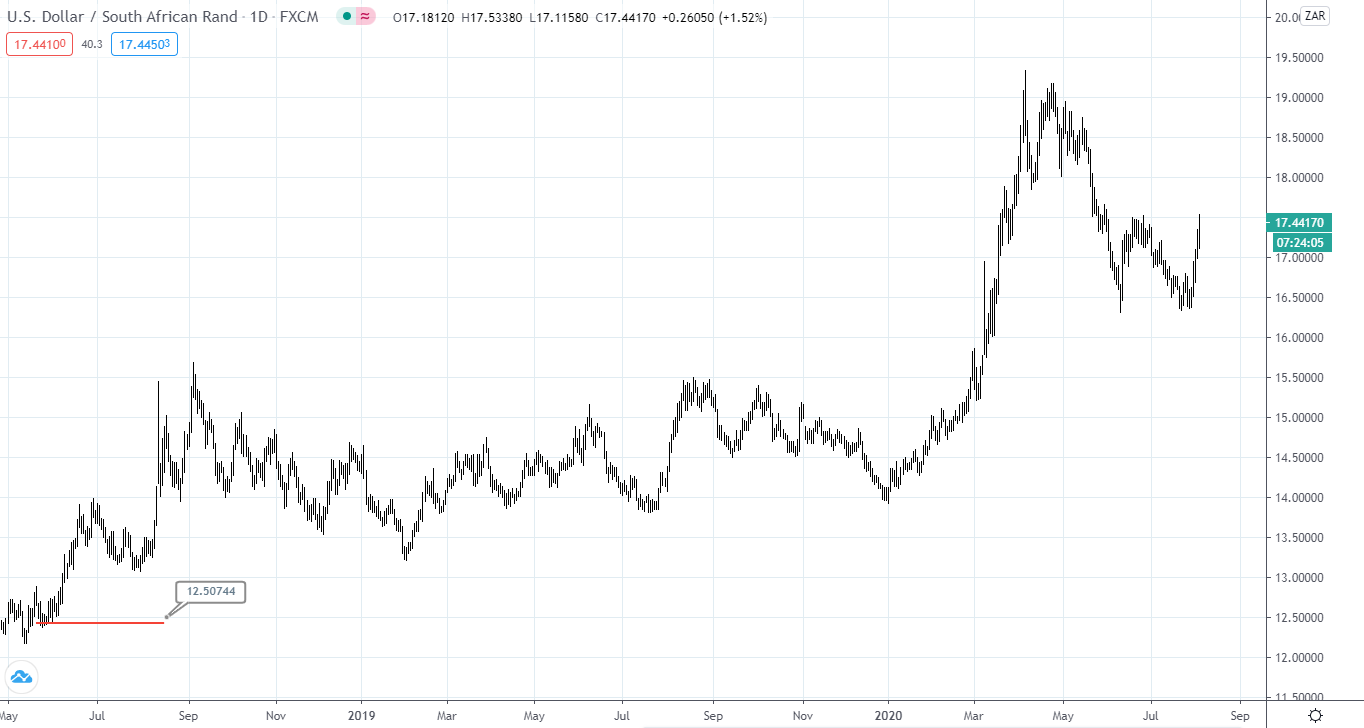Business Tips brings you deep market insight and solutions
As a business owner I know that when I pick up the paper or land on a blog, I am looking for ideas that turn my business on. Today we find it all on repeat…put a mask on, more corruption surfaces and a crashing economy.
Let’s delve into the future and work our way back to the present for a clearer picture
With all the current factors taken into account, it is important to note is that economists expect the rand to weaken to R25 per dollar by 2025. If we take a look at the price chart below we can see that R12.50 was last seen towards the end of April in 2018. Since then we have seen price move with high volatility and is currently at 40% towards the R25 target.
This makes the remaining 4 and 1/2 year period seem like much more than R25 to the dollar being possible. This is the information needed to plan a solid course of action for business to excel going forward.
Taking a look at the relationship between China, Australia and South Africa
China is Australia’s biggest trade partner with a value of $235bn traded between 2018-2019. There is also a strong trade relationship between South Africa and Australia. In 2016 trade totalling over $2bn with car parts, metals and vehicles (BMW) being the major products. This makes Australia the 6th largest export destination for SA, a pretty big deal.
The significance of China
- Being the world’s biggest producer, China accounts for the most manufacturing goods produced on the planet
- It is also very close to afford its own entire output on services
- In agriculture China has almost 300 million farmers. This is more than the population of most countries
These three industries are what makes China’s economy so powerful. All despite being an emerging market economy.
Covid-19 impact
The Chinese new year at the end of January 2020 lead into February and businesses closed for the period. The first lock down started on 23 January in Wuhan and lasted for a total of 59 days. By this time many other countries started sliding into lock down. Subsequently the demand for products and services declined. At the end of February, Chinese industries were experiencing trading activity levels that were about 35% lesser than usual.
China is also SA’s biggest trading partner having surpassed the US in 2009. If we look at the trade relationships between SA, Australia and China it becomes clear just how vulnerable SA really is.
Car sales in Australia fell by almost 50% by the beginning of May 2020 and has maintained a double digit decline for SA in June. So we can see how the impact follows a path down the chain from China to Australia and finally SA.
This leaves a worrying outlook for the remainder of 2020 but the insight will help business owners to plan for what lies ahead.
Top performing industries
The best performing industries are a handful for resource rich SA, leading to businesses adapting their approach and who they work with to be able to move forward:
- Construction
- Online retail
- Information technology
- Business services
- Manufacturing
While the pandemic seems far from over, the Chinese economy has returned a 3.9% recovery in April with factories returning to production progressively. The demand for manufacturing goods and some services will increase as companies work to reach pre-covid trade levels.
Business tactics
The best chance SA businesses have is to break through the pandemic woes by thinking long term. This means building an online presence and trust with potential clients. Consumers and businesses have tweaked spending habits to trim where possible. Generating sales is now a brand new ball game and effort and care will help to secure new relationships.
Over the last four months I have found that B2B relationships have brought easier conversions. It has paved the way to mutually beneficial business relationships to drive revenue.
In the decade of 2002 – 2012 there were two outbreaks (SARS and Ebola) so covid-19 should in fact be no surprise. We should expect more outbreaks in the future if we consider the historical data from 2002. The current average is 1.5 per decade so the expectation of another before 2030 is very likely.
With the above in mind business owners are now taking charge of future planning through the following:
- Investing to be able to weather future shocks that may occur
- Setting up access to funding to have a credit facility for “in case”
- Education based marketing to win the trust of potential clients
- Financial planning eg. updating wills and estate management policies
The SA economy also correlates to the US economy to a large extent due to trade relations and can be a great indicator for the economy and trends. In short, when the big guys suffer, so do we.We are all experiencing things that are at unprecedented levels but we can also have more control over the narrative of our destination in business by planning ahead. The decisions that we are making today will determine how bright our future will be.
“Someone is sitting in the shade today because a tree was planted 10 years ago” Warren Buffett


